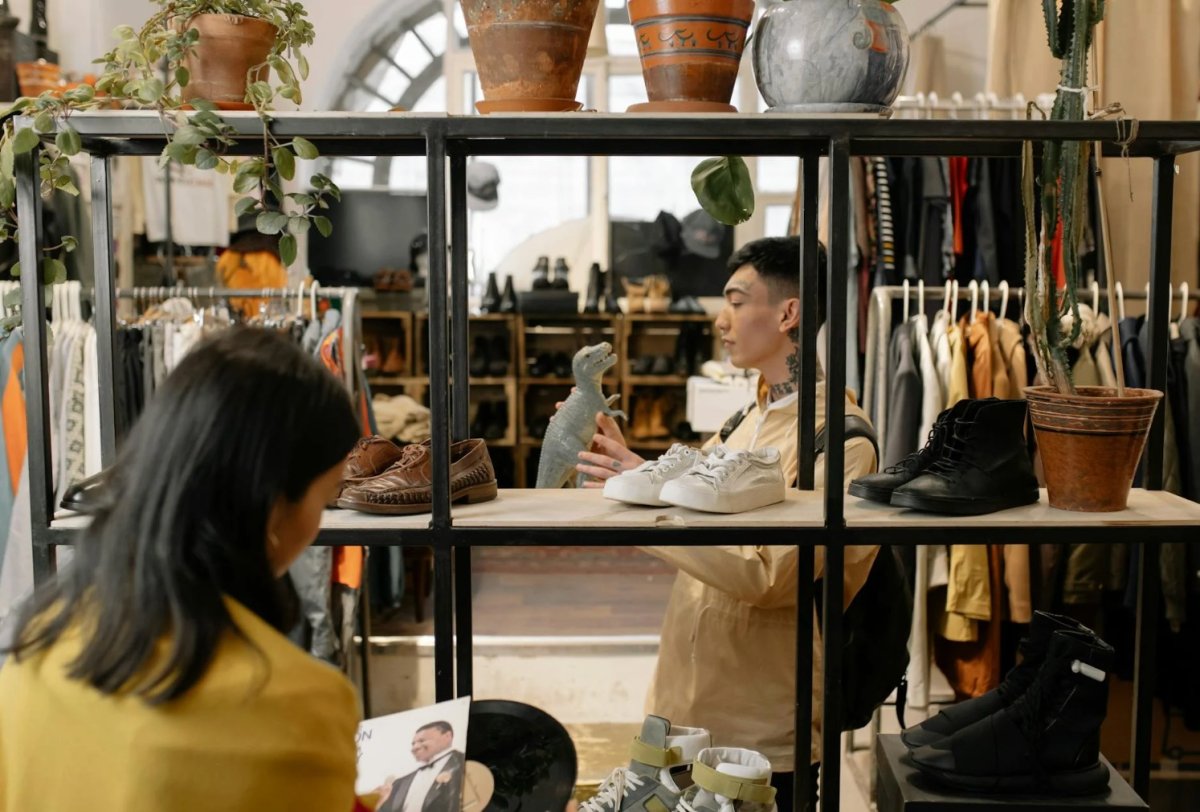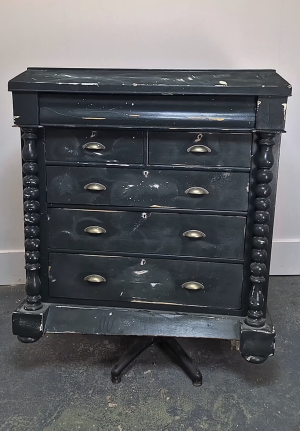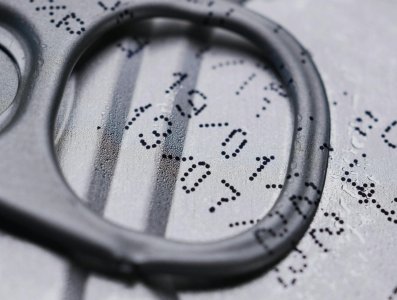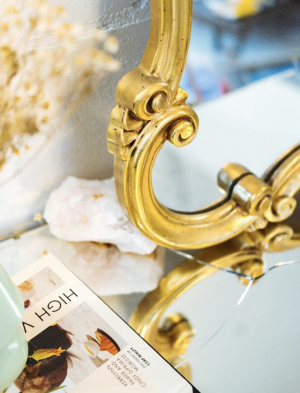
There's something magical about discovering a genuine leather jacket for $8 or a vintage china set for the price of a coffee shop latte. For many Americans over 60, thrift shopping has become both a practical necessity and an enjoyable pastime—a way to stretch retirement dollars while finding unique treasures that younger shoppers often overlook.
But not every bargain is actually a good deal.
Some thrift store finds can end up costing you significantly more than their price tags suggest, while others might even pose health or safety risks.
With Americans over age 60 reporting around $3.4 billion in total fraud losses in 2023, it's clear that shopping smartly—whether online or in person—requires extra caution at our age.
Virginia Chamlee, author of "Big Thrift Energy" and a seasoned thrifting expert, has identified five common warning signs that can help you avoid costly mistakes.
Her insights, combined with safety considerations particularly important for older adults, can help you shop with confidence and bring home only the treasures that truly add value to your life.
"I always try to view an item's cost this way: How long did you spend finding it? How far did you drive to get it? What did you pay for it? If it's a project piece, what did you put into it?"
The “project piece” trap: when cheap becomes expensive
Those adorable but slightly damaged items can be irresistible.
A solid wood dresser with just a few scratches, a vintage lamp that needs rewiring, or a beautiful blazer missing a single button—these “project pieces” seem like obvious bargains, especially when you're on a fixed income.
However, Chamlee warns that these apparent deals often become expensive disappointments.
Restoration costs can quickly exceed what you'd pay for a similar item in good condition, and that's assuming you actually follow through with the repairs.
"I also think in general it's easy to want to buy a lot of stuff because the prices are more affordable," Chamlee explains.
"But that contributes to the endless cycle of consumerism. I try to edit my finds as best I can."
Before picking up that project piece, ask yourself honestly: Do you have the tools, skills, and time to complete the repair?
If you'll need to hire someone, get a rough estimate of the cost. Factor in your time and transportation costs too.
Often, that $15 chair becomes a $75 investment once you add professional reupholstering.

Also read: Could these $2,000 jeans really be just $2.70? A Goodwill story
Stained and damaged clothing: more than meets the eye
That gorgeous silk blouse with a small stain might seem like a steal, but Chamlee advises extreme caution with damaged clothing.
Set-in stains are notoriously difficult to remove, and what looks like a simple spot could actually be something much worse.
"Some stains could actually be mold," Chamlee warns, which presents particular health concerns for older adults who may have respiratory sensitivities or compromised immune systems.
For clothing purchases, wash the garment and dry on the hottest dryer setting before wearing, as recommended by thrift shopping expert Donna Brody.
This step is especially important for seniors, as our immune systems may be more vulnerable to bacteria or allergens that previous owners might have left behind.
When evaluating clothing, always check the care label first.
If that silk blouse requires dry cleaning, factor those costs into your decision.
A $5 shirt that needs $12 worth of dry cleaning isn't such a bargain after all.

Items with strong odors: trust your nose
Strong odors in thrift items aren't just unpleasant—they can signal deeper problems.
While some scents can be neutralized with vinegar treatments, others indicate issues that may be impossible to resolve.
Chamlee specifically recommends avoiding items with animal odors, but seniors should be particularly cautious about any strong smells that might trigger allergies or respiratory issues.
Musty odors could indicate mold or mildew, which can be especially problematic for older adults with breathing difficulties.
If you're considering furniture with odors, remember that professional cleaning or reupholstering costs can be substantial.
"You can always have things reupholstered, though often if it's very old and worn, the reupholsterer will need to build back the cushions, which could be quite costly," Chamlee notes.

Recalled items: a hidden danger, especially for grandparents
This is where thrift shopping can become genuinely dangerous, particularly for seniors who might be purchasing items for visiting grandchildren.
Car seats have expiration dates, and strollers, cribs, and bikes could be unsafe due to outdated safety standards.
"I always advise people to do a bit of research to ensure an item hasn't been recalled—this is especially true for household electronics or anything that could prove dangerous," Chamlee emphasizes.
Before buying anything that plugs in, has moving parts, or will be used by children, do a quick search on the Consumer Product Safety Commission website (cpsc.gov).
Test electrical items in the store to be sure they work properly, and don't assume that because something looks fine, it meets current safety standards.

Items to avoid for safety reasons
Car seats (expire and safety standards change frequently)
Cribs and playpens (may not meet current safety codes)
Electrical items without testing them first
Stuffed toys (difficult to properly sanitize)
Bicycle helmets (may have invisible damage)
For toys, avoid all stuffed toys.
Instead, stick with all-plastic secondhand toys that can be easily disinfected with Lysol or other strong cleaners.
Chipped and cracked goods: safety first
While a small chip might seem like a minor flaw, it can create safety hazards that are particularly concerning for older adults.
Cracked glasses can shatter unexpectedly, chipped plates can cut you while washing them, and damaged ceramics may have sharp edges that are difficult to see.
"I stay away from anything that's fragile and broken or unusable," Chamlee advises.
This is especially wise advice for seniors who may have reduced dexterity or visual acuity that makes handling damaged items more dangerous.
Consider also that damaged items may not function as intended.
A vase with a hairline crack might leak water onto your furniture, and chipped serving dishes may harbor bacteria in the damaged areas.

Also read: Love a good deal? This city is the thrift capital of America
Maximizing your thrift shopping success
The good news is that smart thrift shopping can still yield incredible bargains and unique finds.
An Italian glass vase purchased for $3.99 sold for $107,000 at auction last year, proving that treasures are still out there for those who know how to look.
Here's how to shop smarter:
Time your visits strategically—watch for discount days for seniors, military members, and first responders.
Most Goodwill stores offer discounts for people 55-plus, but local markets set their own policies.
Focus on high-value items—look for quality materials like silk, leather, and natural fibers.
Retro consumers, including nostalgic boomers, have driven a resurgence in vinyl records, with US sales of vinyl records growing 10 percent from 2022 to 2023, outselling music CDs.
Shop during off-peak hours—early weekday mornings offer the best selection, smaller crowds, and more available staff to help with reaching high items or carrying heavy purchases.
Did you know?
Did you know?
The Salvation Army operates 860 family stores across the country, and Goodwill runs over 3,300 thrift stores nationwide, with many offering special senior discount programs. Call ahead to your local stores to learn about their specific senior discount days and policies.
Also read: One ChatGPT thrift shopping secret could save retirees over $100 a month
What to look for instead
Rather than focusing on what to avoid, concentrate on the items that consistently offer good value: quality cookware, hardcover books, artwork and frames, and solid wood furniture in good condition.
These items tend to hold their value and serve you well for years.
Brand-name clothing in natural fibers, especially pieces that are clearly vintage or designer, often represent excellent value.
Look for items with original tags still attached, or pieces from recognizable quality brands.
Smart thrift shopping essentials for seniors
- Always inspect items thoroughly before buying
- Factor in repair costs, cleaning fees, and your time when calculating true value
- Avoid items that could pose health or safety risks, especially if you're buying for grandchildren
- Take advantage of senior discount days at major chains like Goodwill and Salvation Army
- Focus on quality materials and well-known brands for the best value
- When in doubt, walk away—there will always be more treasures to discover
The thrill of the hunt doesn't have to diminish as we get older, but it should become more strategic.
By keeping these warning signs in mind and shopping with both your wallet and your wellbeing in consideration, you can continue to enjoy the satisfaction of finding genuine bargains while avoiding the pitfalls that turn good deals into expensive mistakes.
Remember, the best thrift store treasure is one that serves you well for years to come, not one that ends up creating more problems than it solves.
Read next:
- This man bought a $5 plate and you won't believe its shocking true value!
- This $40 thrift store find turned out to be worth over $2,000—here’s how it happened
- What people are refusing to buy now—and why these once-affordable items are being ditched
What's the best thrift store find you've ever discovered? Share your treasure-hunting stories and tips in the comments below—we’d love to hear about your most memorable bargains and the lessons you've learned along the way.
Primary Source
https://www.realsimple.com/thrifting-red-flags-to-watch-for-11812119
Online Shopping Safety Tips for Senior Citizens
Cited text: In 2023, the FBI Internet Crime Complaint Center (IC3) revealed that Americans over age 60 reported around $3.4 billion in total fraud losses, an 11% ...
Excerpt: Americans over age 60 reporting around $3.4 billion in total fraud losses in 2023
https://lakehousechippewafalls.seni...g-safety-tips-for-senior-citizens?hs_amp=true
Thrift Store Shopping Tips for Seniors | Seniors Guide
Cited text: Even if you score a piece of clothing still sporting its original department store tag, like our mothers used to say, “You don’t know where that thing...
Excerpt: wash the garment and dry on the hottest dryer setting before wearing
https://www.seniorsguide.com/lifestyle/thrift-store-shopping-tips-for-seniors/
Thrift Store Shopping Tips for Seniors | Seniors Guide
Cited text: Car seats have expiration dates, and strollers, cribs, and bikes could be unsafe.
Excerpt: Car seats have expiration dates, and strollers, cribs, and bikes could be unsafe
https://www.seniorsguide.com/lifestyle/thrift-store-shopping-tips-for-seniors/
Thrift Store Shopping Tips for Seniors | Seniors Guide
Cited text: Test electrical items in the store to be sure they work properly.
Excerpt: Test electrical items in the store to be sure they work properly
https://www.seniorsguide.com/lifestyle/thrift-store-shopping-tips-for-seniors/
Thrift Store Shopping Tips for Seniors | Seniors Guide
Cited text: Insider.com notes, “The faults on cribs, strollers, and car seats aren’t always visible.” · Likewise, avoid all stuffed toys. Instead, stick with all-...
Excerpt: avoid all stuffed toys. Instead, stick with all-plastic secondhand toys that can be easily disinfected with Lysol or other strong cleaners
https://www.seniorsguide.com/lifestyle/thrift-store-shopping-tips-for-seniors/
AARP Smart Guide to Thrift Shopping
Cited text: Appraiser Betty Krulik said La Cueillette des Pommes Cannelle, a painting by Vietnamese artist Le Pho, was a “significant find.” Other Goodwill shoppe...
Excerpt: An Italian glass vase purchased for $3.99 sold for $107,000 at auction last year
https://aarp.org/benefits-discounts/members-only-access/info-2024/thrifting-smart-guide.html
Thrift Store Shopping Tips for Seniors | Seniors Guide
Cited text: Watch for discount days for seniors, military and former military, first responders, etc.
Excerpt: Watch for discount days for seniors, military and former military, first responders
https://www.seniorsguide.com/lifestyle/thrift-store-shopping-tips-for-seniors/
AARP Smart Guide to Thrift Shopping
Cited text: Most Goodwill stores offer discounts for people 55-plus, but local markets set their own policies, explains Onney Crawley, chief marketing officer of ...
Excerpt: Most Goodwill stores offer discounts for people 55-plus, but local markets set their own policies.
https://aarp.org/benefits-discounts/members-only-access/info-2024/thrifting-smart-guide.html
AARP Smart Guide to Thrift Shopping
Cited text: Retro consumers, including nostalgic boomers, have driven a resurgence in vinyl records over the past few years. Revenue from U.S. sales of vinyl reco...
Excerpt: Retro consumers, including nostalgic boomers, have driven a resurgence in vinyl records, with revenue from U.S. sales of vinyl records growing 10 percent from 2022 to 2023, outselling music CDs
https://aarp.org/benefits-discounts/members-only-access/info-2024/thrifting-smart-guide.html






